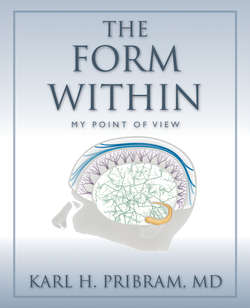Читать книгу The Form Within - Karl H Pribram - Страница 60
На сайте Литреса книга снята с продажи.
FFT: The Fast Fourier Transform
ОглавлениеThe mathematical technique that Fourier developed was published in final form in 1822 as Théorie Analytique de la Chaleur (Analytical Theory of Heat). Today, the once- controversial formula is the basis of the theory known as the “Fourier series”—and with its inverse, the “Fourier transformation”—provides a method whereby we can reduce any perceived configuration, any pattern, no matter how complex, into a series of numbers representing intersections among waveforms. Further, any such series can be restored to its original configuration by performing the transform again, using its inverse.
What Fourier’s method provides us so beautifully is the ability to decompose a configuration, as we experience it, into a series of component parts. For instance, the first component might take in a broad sweep of a scene, of a sound, or of an EEG, and describe it by a low frequency. The next component may then focus on somewhat narrower aspects of the same configuration, and describe it by a somewhat higher frequency. Each subsequent component resolves the pattern into higher and higher frequencies. A series of a dozen components usually succeeds in representing the experienced space-time configuration in sufficiently fine grain to restore it faithfully when the inverse transform is performed. (Recall that performing a Fourier transformation twice returns the original configuration.) The successive components in the Fourier equation accomplish an increasing resolution, providing a finer grain, such as texture, to the configuration.
Fourier’s pioneering method has led to many modifications of his insight, modifications that are grouped under the heading of orthogonal transformations, that is, transformations whose components do not interact with each other. In addition, non-linear modifications have been devised, such as that developed by Norbert Wiener, professor of mathematics at the Massachusetts Institute of Technology, for analyzing the EEG.
Furthermore, the goal of analyzing patterns into a series of component parts can now be accomplished by statistics in which each component in the series is represented by an “order.” Fourth order (that is four terms in the series) must be used to reach the resolution necessary to represent a line or the texture of a visual scene. Statistics, based on enumerating items or things, are usually relatively easy to manipulate in calculations. Thus, statistical techniques are taught to every student who aspires to use or to understand the fruits of scientific enterprise. However, there are drawbacks to the teaching of statistics to the exclusion of other analytical techniques: in the next chapter I discuss how statistical analysis hides the forms behind the manipulations, the symmetries better understood in spectral terms.
This deeper understanding is one reason why frequency aficionados continue to tout the spectral domain. In addition, there is a most useful practical application: transforming into the spectral domain (and back out again) makes the computation of correlations, the basis of “imaging,” simpler, whether by brain or computer. (The procedure uses “convolution,” a form of multiplication of the spectral transformations of what needs to be correlated.)
I remember how we cheered the achievement of a computer program that would perform the Fourier transformation, the Fast Fourier Transform (FFT), while I was at the Center for Advanced Studies in the Behavioral Sciences at Stanford, California, in 1958–59. As a result, its use has become commonplace in medical image processing as in PET (positron emission tomography) scans and fMRI (functional Magnetic Resonance Imaging.) These successes raise the question: Might biological sensory functions also be based on spectral image processing? The next sections show that, not only can the Fourier theorem be usefully applied, but that its application resolves some longstanding problems in the understanding of the neurobiology of visual perception.
